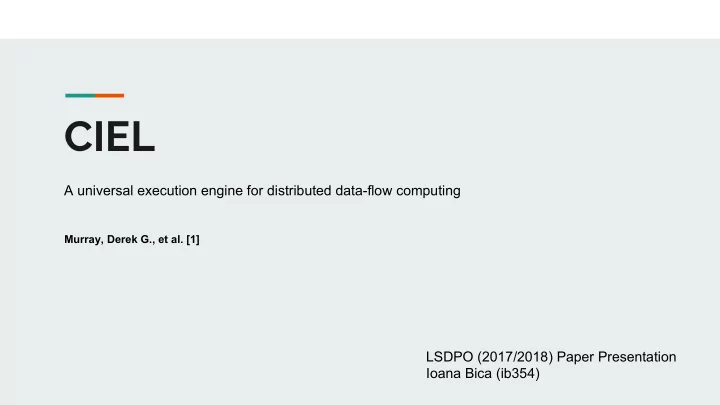

CIEL A universal execution engine for distributed data-flow computing Murray, Derek G., et al. [1] LSDPO (2017/2018) Paper Presentation Ioana Bica (ib354)
Overview 1. Motivation and related work 2. CIEL’s contributions 3. Dynamic task graph and system architecture 4. Skywriting 5. Fault tolerance 6. Evaluation 7. Final remarks 2
Motivation Existing distributed execution engines (MapReduce and Dryad) were inefficient ● for iterative algorithms. MapReduce job [2] Dryad job [3] 3
Related work Adding iteration capabilities to MapReduce: CGL-MapReduce ● Do not provide transparent fault tolerance. Do not support task dependency graphs. HaLoop ● Job latency is increased by consecutive iterations. Apache Mahout ● 4
Related Work Providing data-dependent control flow: Composition of multiple computations not possible. Pregel ● Only operates on a single dataset. (Google’s execution engine) Does not provide transparent scaling. Piccolo ● Fault tolerance involves checkpointing. (data-centric programming model) 5
CIEL dynamic control flow ● dynamic task dependencies ● transparent fault tolerance ● transparent scaling ● data locality ● Can execute iterative and recursive algorithms as a single job. 6
Contributions CIEL: dynamically builds a data-flow DAG as tasks execute ● increases the algorithmic expressibility in execution engines, by allowing ● iterative or recursive algorithms to be executed as a single job implements memoization of task results ● makes improvements to the fault tolerance mechanism ● 7
Dynamic task graph Consists of the following CIEL primitives: objects ● unstructured sequence of bytes ○ with unique name ○ references ● future reference concrete reference object name loc_1, loc_2, …., loc_n tasks ● 8
Tasks input dependencies Non-blocking atomic computations. object_1 object_2 publish objects Tasks TASK spawn new tasks object_3 Cycles cannot be formed in the dependency graph. expected output 9
Dynamic task graph example 10
Lazy evaluation of objects Start from the resulting object and recursively evaluate tasks as their dependencies become concrete. 11
System architecture maintain current state of the dynamic task graph keeps track of references published by tasks and the new spawned tasks Tasks are dispatched to the worker nearest to the data. 12
Skywriting Turing complete programming language ● used to write parallelised jobs that can run on CIEL ● dynamically typed ● allows data mapping mechanisms through static file referencing ● Skywriting can express arbitrary data-dependent control flow. 13
Key features ● ref(url) ● spawn(f, [args, …]) ● exec(executor, args, n) ● spawn_exec(executor, args, n) * - dereference unary operator ● 14
Using Skywriting to create tasks Explicitly: using spawn() or spawn_exec() ● Implicitly: using the *- operator ● 15
Memoisation memoise task results ● enabled by using deterministic naming for the objects: ● executor H(args||n) i and by using lazy evaluation (only execute tasks if there outputs can resolve ● dependencies) 16
Fault tolerance Worker failures are handled similarly to Dryad ● re-execute task performed by failed worker ○ re-execute tasks using data from the failed worker ○ Master failure: does not force the entire job to fail ● derive master state from set of active jobs ○ use persistent logging and secondary masters ○ 17
Evaluation grep benchmark ● k-means clustering ● dynamic programming ● shows that CIEL has increased algorithmic expressivity compared to ○ MapReduce impact of master failures on performance ● No recursive algorithm? ● 18
Grep 19
k-mean clustering CIEL achieves higher cluster utilization and less constant overhead ● CIEL is not any more scalable than Hadoop ● 20
When to use (or not) CIEL? CIEL enables clients to run iterative and recursive algorithms in a highly ● parallelized manner with transparent fault tolerance and transparent scaling CIEL was designed for coarse-grained parallelism across large data sets ● For fine-grained parallelism, work-stealing schemes are better. ○ If data fits into RAM, Piccolo is more efficient. ○ If jobs share a lot of data, OpenMP is more appropriate. ○ For better scalability and performance use MPI . ○ 21
Drawbacks and ideas for improvement CIEL does not control the number of tasks it spawns. ● Modifications to the data flow graph during execution are centralized. ● When a worker fails, all of the tasks that depend on the task executed by that ● worker need to be re-executed. 22
References [1] Murray, Derek G., et al. "CIEL: a universal execution engine for distributed data-flow computing." Proc. 8th ACM/USENIX Symposium on Networked Systems Design and Implementation . 2011. [2] www.cdmh.co.uk [3] www.microsoft.com [4] Dean, J., and S. Ghemawat. "MapReduce: simplified data processing on large clusters. OSDI’04 Proceedings of the 6th conference on Symposium on Opearting Systems Design and Implementation”, dalam: International Journal of Enggineering Science Invention." URL: http://static. googleusercontent. com/media/resear ch. google. com (diunduh pada 2015-05-10) (2004): 10-100. [5] Isard, Michael, et al. "Dryad: distributed data-parallel programs from sequential building blocks." ACM SIGOPS operating systems review . Vol. 41. No. 3. ACM, 2007. 23
Thank you! 24
Questions? 25
Recommend
More recommend